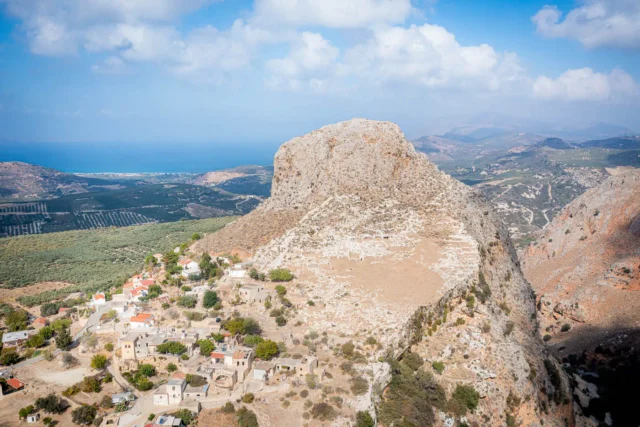A Symbol of Cretan Resistance
Kandanos is a village located in the White Mountains of Crete, within the municipality of Kantanos-Selino, Chania regional unit. It sits at an altitude of 580 meters in a fertile plateau and is situated approximately 54 kilometers southwest of Chania town. Historically the heart of the Selino province, Kandanos is known for its long history, its tragic destruction by German forces during World War II, and its resilient spirit in rebuilding and preserving its heritage.
Etymology
The name Kandanos is believed to be derived from the word “Kantanía,” meaning “city of victory,” or from “Kántores,” meaning “the rulers.”
Historical Overview
Ancient Era: Kandanos has a history that stretches back to the Dorian period, with its first settlement built in the present location around 1049 BC. It is mentioned as one of the 100 cities in Homer’s works. During the Hellenistic period, it appears to have been part of the “Koinon ton Oreon” (Community of the Mountains) along with other cities in Selino. The city flourished in the Roman and early Byzantine periods. Around 1937, archaeologist V. Theofanidis excavated a large building in the center of the village, revealing a structure with sides of 30 meters and a floor area of 900 square meters paved with mosaics. A base of a statue dedicated to the Roman emperor Septimius Severus was also found. This Roman building is thought to have been the praetorium (administrative headquarters) of the area, later used as a church.
Byzantine and Venetian Eras: In the early Christian period, Kandanos was the seat of a bishopric, with its first bishop ordained by the Apostle Titus. Bishops from Kandanos participated in early ecumenical councils. The village was destroyed by Arab raiders in the 9th-10th centuries and remained deserted until it was re-inhabited during the Venetian period in the 12th century. It prospered under Venetian rule, with many Byzantine churches built during this time. Among the most important is the church of Agia Anna in Anisarakion, featuring a rare depiction of Saint Anna breastfeeding the Virgin Mary. Other notable Byzantine churches include Agios Ioannis Theologos (1328-1329) in Trachinikos and Michail Archangelos (1327-1328) in Kavallariana.
Ottoman Era: During the Ottoman period, Kandanos was an important center and the seat of a Turkish administrator (Kaimakam). The Ottoman “Seragio” (administrative building) was located on the hill where the police station now stands. The village was a frequent site of conflict between Christians and Turks. The Turks built towers at strategic points to control the plateau and strengthen their defenses. During the Greek War of Independence in 1821, Kandanos served as a refuge for the Turks. In 1823, a siege of Turkish-held towers in Kandanos by Cretan rebels led by Tombazis resulted in a truce and the retreat of the Turks to Chania. Kandanos was also a key location in the Cretan Revolt of 1866, with the first shots of the revolution fired there by Konstantinos Kriaris. In 1897, Turkish forces from across Selino gathered in Kandanos but were eventually forced to leave under the protection of foreign powers.
World War II and the Destruction of Kandanos: In May 1941, during World War II, the people of Kandanos, along with residents of neighboring villages, resisted the German invasion of Crete. They fought in the Battle of Floria on May 23rd and the Battle of Kandanos Gorge on May 24th-25th, inflicting significant losses on the German forces. In retaliation for this resistance and alleged atrocities against German soldiers, German forces, under the orders of General Kurt Student, completely destroyed Kandanos on June 3rd, 1941. They burned all the houses and killed any remaining elderly or bedridden inhabitants. They also prohibited the rebuilding of the village and left behind signs declaring that Kandanos was destroyed and would never be rebuilt. Kandanos is the only place where the Germans left written evidence of the destruction they caused.
Rebuilding and Modern Era: After the German withdrawal, Kandanos was rebuilt in its present location. Today, it is a small town with approximately 500 permanent residents. The economy is based on agriculture, livestock farming, trade, and services. The village has various amenities, including schools, a police station, a health center, and hotels. With the 2011 local government reform, the municipality of Kandanos merged with the municipalities of Pelekanos and Anatoliko Selino to form the new municipality of Kantanos-Selino.
Population Data
Year |
Population |
|---|---|
1991 |
421 |
2001 |
564 |
2011 |
421 |
2021 |
383 |
Points of Interest
- Byzantine Churches: Kandanos has numerous Byzantine churches with frescoes, including Agia Anna, Agios Ioannis Theologos, Michail Archangelos, Agios Georgios, and Agia Kyriaki.
- War Memorial: A local war memorial commemorates the destruction of the village in World War II and displays replicas of the signs left by the Germans.
- Traditional Architecture: The village features traditional Cretan architecture, with stone houses and narrow streets.
- Surrounding Area: The surrounding area offers opportunities for hiking and exploring the natural beauty of the White Mountains.
Village Key Points
- Historical References: Mentioned in ancient texts as one of the 100 cities. Historically significant for its role in Cretan resistance against foreign powers.
- Location: Chania regional unit, Crete, Greece. 54 km southwest of Chania town, in the White Mountains.
- Altitude: 580 meters above sea level.
- Historical Significance: Ancient city dating back to the Dorian period. Completely destroyed by German forces in World War II. A symbol of Cretan resistance and resilience.
- Current Status: A thriving village with a strong connection to its history and traditions.
Access
Kandanos is 12.2 kilometers away from Palaiochora and 10.8 kilometers away from Sougia






















There are no comments yet.